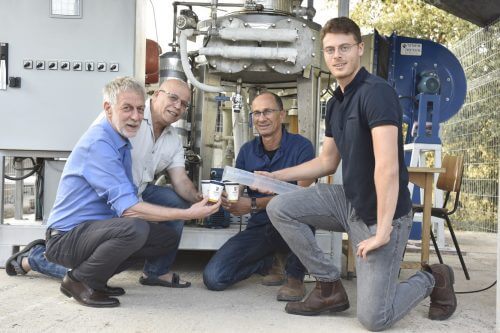The new system will enable regular water supply even to small and isolated communities, without the need to transport water from long distances

According to the World Health Organization (WHO), about half of the world's population will suffer from a lack of drinking water as early as 2025. Therefore, access to clean water, which is one of the 17 goals for sustainable development established by the United Nations in 2015, was the motivation for the development of an independent and mobile system that produces water from the air The system developed at the Technion will be able to provide clean water even to isolated communities far from water sources.
The developers of the new technology are Prof. David Brodai and Prof. Eran Friedler, researchers in the Water and Agriculture Environmental Engineering Unit in the Faculty of Civil and Environmental Engineering and the Water Research Institute at the Stefan and Nancy Grand Technion, and Ilan Katz, the chief engineer of the system. The three developed the first prototype of its kind in the world: a cheap and energy-efficient system for extracting water from air. The technology is particularly relevant to small and isolated settlements that are significantly far from fresh or salt water sources. This is because the cost of transporting water increases with the community's distance from the water source or the desalination plant. Therefore, small and isolated communities will benefit especially from the new system, which allows the water to be produced on site. The Technion's commercialization unit (Technion Technology Transfer - T3) registered a patent on the innovative technology and works with the industry to initiate and commercialize it with the aim of leveraging intellectual property assets to create breakthrough innovation that is accessible to the general public.
The new technology is based on a two-stage cycle process: separating the water vapor from the air by absorbing the water vapor with a dedicated concentrated salt solution (desiccant) and then separating it from the solution at subatmospheric pressure. According to Prof. Brodai, "One of the advantages of the new technology, along with the energy efficiency, is the fact that the water undergoes significant treatment when passing through the salt solution. Our development makes water an attainable resource, as it makes it possible to produce water anywhere in the world, regardless of existing water sources. The prototype we built shows that the method works, and we hope that in the near future we will turn the system into a commercial product."
In contrast to existing technologies for producing water from air, which are based on massive cooling of all the air that enters the system, the new system developed at the Technion cools only the water vapor and thus significantly reduces the energy required to produce water. According to Prof. Friedler, "The existing technologies work with direct cooling, meaning they cool all the air that enters the contents and condense the water vapor (similar to the operation of an air conditioner). Therefore, in these systems there is a waste of energy because they cool all the air while the water vapor only makes up about 3% of the air mass (even when the relative humidity is 100%)."
"We do not compete in desalination," clarifies Prof. Brodai. "Israel is a developed country located on the coast that can supply itself with all its water consumption through desalination systems. This is partly because it is a relatively small country and a significant part of its inhabitants live along the coast, so that there is no need to transport desalinated water over great distances. Supplying desalinated water to the communities living very far from the sea, on the other hand, is very expensive due to the need for very long transport pipelines. Here the advantages of the new technology we developed are evident."
Prof. Friedler emphasizes that "in addition to water being an essential element for life directly, it affects other important aspects, including the health status of the individual and the community, and even the empowerment of women - because in many places girls do not get an education because they are busy providing water for the family, and also in their adulthood They spend hours transporting water. In addition, it is important to note that even today the issue of water is a major factor in bloody conflicts in dry areas, such as Africa, and is also one of the significant motives for mass migration to Europe."
Ben Gido, who was a master's student at the Faculty of Civil and Environmental Engineering, Dr. Gomid Khaled from the Energy Laboratory at the Faculty of Mechanical Engineering, PhD student Yigal Evron from the Faculty of Mechanical Engineering (under the guidance of Dr. Khaled and Prof. Emeritus Gershon Grossman) and student Liron Huber from the faculty participated in the development of the system over the years. for civil and environmental engineering.

5 תגובות
In 2004, I purchased a similar system made in the United States. It is not clear to me what has changed in the Israeli system.
The system I purchased is still working and powered by a solar collector.
Not like that
hydrogen??
An article that mostly explains what everyone knows - how important water is to life - and does not provide basic facts for evaluating the economics and viability of the device. For example, what is the specific energy consumption in watt-hours per liter (or kWh per cubic meter), what is the specific investment needed, and with these two main cost components, what is the cost of the water that will be produced.
For years there have been such machines in many villages in Africa, it's really not a new technology